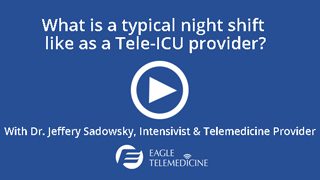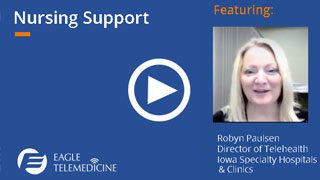Tele-Critical Care seems like an odd choice to support hospitals at night. Yet, most ICU admissions occur during the night shift, and those admitted in the earliest morning hours have the worst prognosis – with significantly higher mortality rates. That’s the finding from a 9-year study of ICU admissions, and a cautionary tale for hospitals everywhere – especially small community hospitals that often struggle with night shift staffing.
In many cases, small hospitals must utilize costly locum tenens physicians or try to recruit a full-time provider to cover nights. Otherwise, the daytime physician takes the on-call shift in addition to their daytime duties, leading to increased risk for burnout. None of these are sustainable, long-term solutions.
Telemedicine can save the day (and night). We know this to be true after over a decade of providing high quality telemedicine care to hospitals and patients in need. With over 14 specialties to choose from, and customized coverage models specific to your community’s needs, there’s something for everyone. We know nights can be particularly challenging, and we’re here to help.
Effective handoffs and physician documentation in the medical record provide a safe transition between days and nights. Patients are able to stay in their community to receive high quality care. And nursing staff has ready access to physicians overnight. Care is not delayed. The Eagle physicians are very responsive. I know I can count on them to provide high quality physicians.
– Catherine Hamilton, Chief Nursing Officer at Saint Luke’s – Hendrick Medical Center and Wright Memorial
4 Benefits of Tele-Critical Care and TeleHospitalist Night Coverage
1. Improved Patient Care
In many hospitals, the local physician has a clinical practice plus hospital rounds during the day and provides on-call coverage at night. Understandably, floor nurses are reluctant to wake that physician in the middle of the night with their questions. While night shift nurses typically know the treatment steps to follow, there can be a change in patient status at any time and they may require assistance from the on-call physician.
TeleNocturnist companies take the burden off nurses and prevents them from having to wonder if a concern is large enough to warrant waking the on-call physician. TeleNocturnists are wide-awake and ready for anything that may arise during the night. Nurses feel more comfortable calling or sending a secure text to a TeleNocturnist at any time. With response times typically under 3 minutes, nurses receive answers in real-time, resulting in better patient care during the night.
The telemedicine provider is able to fully document every aspect of night shift patient care within the hospital’s EMR and participates in patient handoffs at shift change. This is huge for maintaining consistency of care between day and night shift providers.
2. More Frequent Rounds
TeleHospitalists and Tele-Critical Care can participate in patient rounds via live video-conferencing, and can “beam in” 24/7, functioning as a full member of your hospital’s clinical team. This is especially critical at night – when risk is highest, research shows. For example, one study found a majority of falls occurred between 7pm and 7am. Another found higher ICU readmission rates with nighttime transfers from the ICU and longer average length of stays – compared with the daytime numbers.
Nighttime risks can be found across all areas of the hospital and affect all types of patients. In addition to the ICU risks, studies also show patients admitted at night with stroke symptoms have higher mortality risk. Early morning hours (pre-dawn) are also a big risk for patients with ischemic stroke and myocardial infarction.
Researchers at one hospital believed that a lack of formalized communication at night (vis a vis, rounds) were at the crux of the problem. During a quality improvement initiative, they implemented night rounds. By doing twice-daily rounds, once during the day and once at night, floor nurses gained more time to discuss patient cases, concerns, questions and anticipated issues. The patients’ improved outcomes showed they were right and nightly rounds proved to be a very positive addition to night shift protocols.
What is a typical night like as a Tele-ICU provider?
Dr. Jeffery Sadowsky, Tele-Critical Care physician and intensivist explains how telemedicine care works in the ICU.
3. Better Staff Management
Physicians struggle to achieve even a modest life-work balance when they’ve got a full clinical load plus hospital hours – along with being on-call nights and weekends. Many rural hospitals struggle to recruit one full-time physician, let alone the fully staffed team required for 24/7 coverage. It can be a major burden on the provider and lead to serious burnout.
Small hospitals have lost physicians because the on-call demands were too great. When there’s nighttime coverage by a TeleNocturnist, dayshift providers are not burdened with call coverage on nights, weekends and holidays. For small rural community hospitals, this coverage has proven necessary in retaining highly valued physicians.
Eagle’s TeleNocturnists and Specialists are well-adjusted to handling day and night schedules, as their top priority is patient care. They work with just a small number of hospitals, so there’s never any danger that they are “spread too thin.” Each TeleNocturnist and Specialist recognizes and values the role they play in hospital care, and is dedicated to serving their hospital patients – treating each patient with great respect, and valuing their connection with each.
Does Telehealth Help Nurses?
Why does telehealth for nurse practitioners, physician assistants and the wider nursing team benefit the hospital and its patients? Nurses know that a fast response is critical to patient care.
4. Cost savings
Reduces need for locum tenens
Too often, small rural hospitals must rely on locum providers to shore up their weekend and night coverage. Locums are a great resource for sudden staffing crises, but the expensive costs make it an unsustainable long-term solution for most community hospitals.
In one study, telemedicine significantly reduced an Eagle partner hospital’s locum support costs by $200,000+ annually. In addition, hospital revenue increased by $55,000+ because more patients were treated on-site.
Avoids the high cost of hiring additional full-time physicians to cover the night shift and weekend
Recruiting hospitalists and multiple specialists has never been easy for rural and small community hospitals. Salaries are competitive and therefore costly. Many physicians prefer to practice in larger metropolitan cities leading to the current geographic maldistribution of providers.
“Our industry survey found that some health systems were able to reduce spend on staffing by 30% or more for certain service lines by leveraging telemedicine as an alternative to a staffing agency,” one researcher reported.
Retain more patients, reduce transfers
Without local physicians available, patients must be transferred to distant tertiary facilities – often 80 to 100 miles away. Transfers can be an undesirable added stress to patients and their families, who would much rather be able to receive treatment close to home in their own community.
Whether it’s a husband whose wife is at home with Parkinson’s and he’s hospitalized he wants to stay at home or if it’s single mom and she’s got to coordinate her kids – transfers are a big deal for them. The ability to keep more patients home and feeling really good about the care they are being provided with is a huge benefit we found with telemedicine.
– Robyn Paulsen, Director of Telehealth, Community, and Business Development Administration, Iowa Specialty Hospitals & Clinics
Why partner with Eagle?
For rural hospitals, the economies of scale of sharing night shift costs across multiple other rural hospitals make Eagle’s TeleNocturnist and TeleIntensivist programs a sustainable solution. The on-site staff can tap their Eagle provider any time of night and receive a near immediate response in addition to the telemedicine provider’s participation in nightly rounds. Access to high-quality care through telemedicine ensures the community has the best medical resources during every night shift, weekends and holidays. Local medical staff can rest easy knowing their patients are in very good hands and receiving continuity of care day and night.








